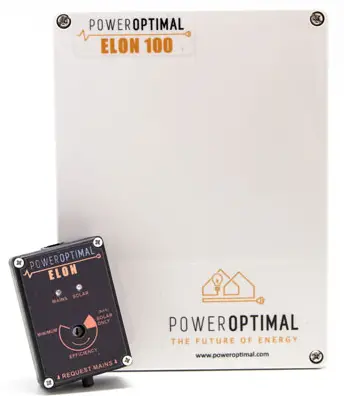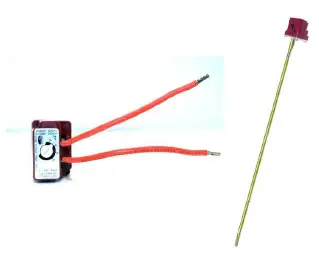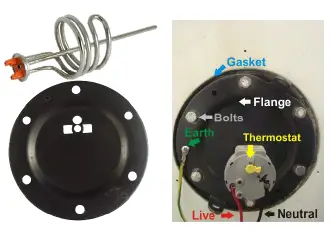POWEROPTIMAL Elon 100 Solar Pv Array and Heating Element

Solar PV Array and Heating Element Selection Guide
The Solar PV Array and Heating Element Selection Guide provides easy selection guide for general users and a more detailed and technical selection guide for solar PV designers and engineers. The document version is 2.08.
Section A: Easy Selection Guide
This section provides an easy selection guide on how many solar panels are needed for delivering hot water in South Africa and what size of heating element should be used.
How Many Solar Panels Do I Need?
The table below shows approximately how much hot water will typically be delivered by different sizes of solar PV array in South Africa. The most important factor is the power (in kWp) as opposed to the number of modules.
| Solar PV Array Size (kW) | Showers per Day* | 50%+ of Daily Hot Water Use Provided for How Many People? | How Many People Off-grid for Hot Water? | Typical Number of Solar PV Modules |
|---|---|---|---|---|
| 2 – 3 modules | 3 | 1-2 | 1-2 | 2-3 modules |
| 3 – 4 modules | 4 | 2-3 | 2-3 | 3-4 modules |
| 4 – 5 modules | 6 | 3-4 | 3-4 | 4-5 modules |
| 6 – 8 modules | 8 | 4-5 | 4-5 | 6-8 modules |
| 8 – 10 modules | 10 | 6-7 | 6-7 | 8-10 modules |
What Size Heating Element Should I Use?
The table below shows the best matching geyser element size based on the solar PV array size in kWp.
| Solar PV Array Size (kWp) | Best Matching Geyser Element Size (kW) | 2nd Choice Geyser Element Size* (kW) | Geyser (Water Tank) Size (Litres) |
|---|---|---|---|
| 4 | 3 | 4 or 2 | 100 – 200 |
| 3 | 4 or 2 | 3 | 100 – 200 |
| 2 | 3 | NA (two parallel PV strings) | N/A |
Section B: Solar PV Array and Heating Element Full Selection Guide
This section provides a complete selection guide on how to match the solar PV array and heating elements for maximum power transfer efficiency. Customers can contact PowerOptimal for advice on module-element matching if module properties (maximum power point current and voltage) are significantly different from typical module properties or for advice on bifacial & high voltage modules.
Tables
The following tables provide information on annual average litres of water heated per day and annual average number of showers per day for different locations and solar capacity in kWp installed.
| Location | Bloemfontein | Cape Town | Durban | Jhb/Pretoria | Mbombela | Port Elizabeth | Upington | Saldanha |
|---|---|---|---|---|---|---|---|---|
| Annual Average Litres of Water Heated Per Day for X kWp Installed Solar Capacity |
1894 | 1624 | 1447 | 1724 | 1627 | 1565 | 1912 | 1623 |
| Location | Bloemfontein | Cape Town | Durban | Jhb/Pretoria | Mbombela | Port Elizabeth | Upington | Saldanha |
|---|---|---|---|---|---|---|---|---|
| Annual Average Number of Showers Per Day for X kWp Installed Solar Capacity |
1894 | 1624 | 1447 | 1724 | 1627 | 1565 | 1912 | 1623 |
*Note: Section A provides an easy selection guide for general users. Section B provides a more detailed and technical selection guide for solar PV designers and engineers.
Contact PowerOptimal at info@poweroptimal.com for more information.
Directors: RA Fearon, FS Moolman, JJ Theron, DM
Weber (Independent), IR Jandrell (Independent)
Company registration number: 2012/099947/07
Address: PO Box 5, Kleinmond, 7195
SOLAR PV ARRAY & HEATING ELEMENT SELECTION GUIDE
PowerOptimal Elon® 100
The innovative PowerOptimal Elon® 100 incorporates proprietary solar PV (photovoltaic) power management technology to allow for direct connection of solar PV arrays to electric geysers (water heaters) with optimised solar power use in a single compact unit. The system can be connected to the grid (AC mains) as well, and intelligently switches between AC and solar power supply. The system requires no inverter and no battery. It can be connected to standard AC geyser heating elements and AC thermostats, which translates into the most cost-effective solar water heating option today.
Document Version: 2.08
Note: Section A provides an easy selection guide for general users. Section B provides a more detailed and technical selection guide for solar PV designers and engineers.
SECTION A. EASY SELECTION GUIDE: HOW MANY SOLAR PANELS DO I NEED?
The below table shows approximately how much hot water will typically be delivered by different sizes of your solar PV array in South Africa. The most important factor is the power (in kWp) as opposed to no. of modules.
| Solar PV array size (kW ) p | Showers per day* | 50%+ of daily hot water use provided for how many people? | How many people off-grid for hot water? | Typical number of solar PV modules |
| 1 – 1.2 | 2 – 3 modules |
|||
| 1.2 – 1.6 | 3 – 4 modules |
|||
| 1.6 – 2 | 4 – 5 modules |
|||
| 2.4 – 3.2 (two parallel PV strings) |
6 – 8 modules |
|||
| 3 – 4 (two parallel PV strings) |
8 – 10 modules |
* 6-minute showers at 40 °C with 8 litre/min (low-flow) showerheads
SECTION A. EASY SELECTION GUIDE: WHAT SIZE HEATING ELEMENT SHOULD I USE?
To get the best performance from your Elon® solar PV water heater, it is important that the geyser element is a good match for the size of your solar PV array. This table helps you match the size of the solar PV array with the size of the geyser element.
| Solar PV array size (kWp) | Best matching geyser element size (kW) | 2nd choice geyser element size* (kW) | Geyser (water tank) size (litres) |
| 1 – 1.2 | 4 | 3 | 100 – 200 |
| 1.2 – 1.6 | 3 | 4 or 2 | 100 – 200 |
| 1.6 – 2 | 2 | 3 | 150 – 300 |
| 2 – 4 (two parallel PV strings) | 4 | NA | 200+ |
Maximum allowed solar PV array specifications at Standard Test Conditions (STC):
Isc < 20A Voc < 240V Power < 4 kWp
SECTION B. SOLAR PV ARRAY AND HEATING ELEMENT FULL SELECTION GUIDE
It is important to match the solar PV array and heating elements for maximum power transfer efficiency. HOW TO USE THIS GUIDE:
- Use Tables 1 to 4 to help you select the right size solar PV array for your needs.
- Then use Table 5 to find the recommended AC heating element power rating for your selected solar PV array.
- Use Table 6 to check element & thermostat compatibility with the Elon® 100.
Contact Power Optimal for advice on module-element matching if module properties (maximum power point current and voltage) are significantly different to typical module properties, or for advice on bifacial & high voltage modules.
TABLE 1. ANNUAL AVERAGE LITRES OF WATER HEATED PER DAY
The below example table indicates the average number of litres of water per day that the system will heat from 15 to 60 °C over a year period for different solar array peak power ratings. (The amount of water heated will vary with weather conditions, by geographic location and by season. Water heated per day will be significantly lower in winter and significantly higher in summer. These numbers indicate heating capacity – i.e. if no hot water is used on a given day, there will be less water heated on that day. This is only an approximate guide.)
| Solar + Elon® | Annual average litres of water heated per day for X kWp installed solar capacity | ||||||||||
| Location | kWh/kWp/yr | 0.8 kWp | 1 kWp | 1.2 kWp | 1.4 kWp | 1.6 kWp | 1.8 kWp | 2 kWp | 2.5 kWp | 3 kWp | 3.5 kWp |
| Bloemfontein | 1894 | 80 | 99 | 119 | 139 | 159 | 179 | 199 | 249 | 298 | 348 |
| Cape Town | 1624 | 68 | 85 | 102 | 119 | 136 | 154 | 171 | 213 | 256 | 299 |
| Durban | 1447 | 61 | 76 | 91 | 106 | 122 | 137 | 152 | 190 | 228 | 266 |
| Jhb/Pretoria | 1724 | 72 | 91 | 109 | 127 | 145 | 163 | 181 | 226 | 272 | 317 |
| Mbombela | 1627 | 68 | 85 | 103 | 120 | 137 | 154 | 171 | 214 | 256 | 299 |
| Port Elizabeth | 1565 | 66 | 82 | 99 | 115 | 132 | 148 | 164 | 205 | 247 | 288 |
| Upington | 1912 | 80 | 100 | 121 | 141 | 161 | 181 | 201 | 251 | 301 | 352 |
| Saldanha | 1623 | 68 | 85 | 102 | 119 | 136 | 153 | 170 | 213 | 256 | 298 |
Example:
For a solar PV array of 1.2 kWp, an installation in Johannesburg would yield about 1724 kWh/kWp/yr, or 1724 x 1.2 kWp = 2069 kWh/yr. This would be sufficient to heat on average 109 litres of water per day. For a family of 2 each using 80 litres of hot water per day, this would provide about 109 ÷ (80 x 2) or 68% of the annual hot water requirement.
TABLE 2. ANNUAL AVERAGE NUMBER OF SHOWERS PER DAY
The below table indicates the average number of showers per day for which the system will supply hot water over a year period for different solar array peak power ratings. (The amount of water heated will vary with weather conditions, by geographic location and by season. Water heated per day will be significantly lower in winter and significantly higher in summer. These numbers indicate heating capacity – i.e. if no hot water is used on a given day, there will be less water heated on that day. This is only an approximate guide.)
| Solar + Elon® | Number of showers per day (based on annual average) for X kWp installed solar capacity | ||||||||||
| Location | kWh/kWp/yr | 0.8 kWp | 1 kWp | 1.2 kWp | 1.4 kWp | 1.6 kWp | 1.8 kWp | 2 kWp | 2.5 kWp | 3 kWp | 3.5 kWp |
| Bloemfontein | 1894 | 2.4 | 3.0 | 3.6 | 4.2 | 4.8 | 5.4 | 6.0 | 7.5 | 9.0 | 10.4 |
| Cape Town | 1624 | 2.0 | 2.6 | 3.1 | 3.6 | 4.1 | 4.6 | 5.1 | 6.4 | 7.7 | 9.0 |
| Durban | 1447 | 1.8 | 2.3 | 2.7 | 3.2 | 3.6 | 4.1 | 4.6 | 5.7 | 6.8 | 8.0 |
| Jhb/Pretoria | 1724 | 2.2 | 2.7 | 3.3 | 3.8 | 4.3 | 4.9 | 5.4 | 6.8 | 8.2 | 9.5 |
| Mbombela | 1627 | 2.1 | 2.6 | 3.1 | 3.6 | 4.1 | 4.6 | 5.1 | 6.4 | 7.7 | 9.0 |
| Port Elizabeth | 1565 | 2.0 | 2.5 | 3.0 | 3.5 | 3.9 | 4.4 | 4.9 | 6.2 | 7.4 | 8.6 |
| Upington | 1912 | 2.4 | 3.0 | 3.6 | 4.2 | 4.8 | 5.4 | 6.0 | 7.5 | 9.0 | 10.5 |
| Saldanha | 1623 | 2.0 | 2.6 | 3.1 | 3.6 | 4.1 | 4.6 | 5.1 | 6.4 | 7.7 | 9.0 |
The table is based on 6-minute showers at 40 °C and 8 litres/min low flow showerheads. Old showerheads can use up to 15 litres/min and would substantially reduce the number of showers.
Example:
For a solar PV array of 2.5 kWp, an installation in Johannesburg would yield about 1724 kWh/kWp/yr, or 1724 x 2.5 kWp = 4 310 kWh/yr. This would be sufficient for about 6 to 7 showers per day.
TABLE 3. PERCENTAGE OF ANNUAL HOT WATER REQUIREMENT
The below example table indicates what % of the annual hot water requirement will on average be supplied by the system for 2 people each using 80 litres of hot (60 °C) water per day. (The amount of water heated will vary with weather conditions, by geographic location and by season. Water heated per day will be significantly lower in winter and significantly higher in summer. These numbers indicate heating capacity – i.e. if no hot water is used on a given day, there will be less water heated on that day. This is only an approximate guide.)
| Solar + Elon® | Annual average % of hot water requirement supplied for 2 people each using 80 litres of hot water per day for X kWp installed solar capacity | ||||||||||
| Location | kWh/kWp/yr | 0.8 kWp | 1 kWp | 1.2 kWp | 1.4 kWp | 1.6 kWp | 1.8 kWp | 2 kWp | 2.5 kWp | 3 kWp | 3.5 kWp |
| Bloemfontein | 1894 | 50% | 62% | 75% | 87% | 99% | 112% | 124% | 155% | 187% | 218% |
| Cape Town | 1624 | 43% | 53% | 64% | 75% | 85% | 96% | 107% | 133% | 160% | 187% |
| Durban | 1447 | 38% | 47% | 57% | 66% | 76% | 85% | 95% | 119% | 142% | 166% |
| Jhb/Pretoria | 1724 | 45% | 57% | 68% | 79% | 91% | 102% | 113% | 142% | 170% | 198% |
| Nelspruit | 1627 | 43% | 53% | 64% | 75% | 85% | 96% | 107% | 134% | 160% | 187% |
| Port Elizabeth | 1565 | 41% | 51% | 62% | 72% | 82% | 92% | 103% | 128% | 154% | 180% |
| Upington | 1912 | 50% | 63% | 75% | 88% | 100% | 113% | 126% | 157% | 188% | 220% |
| Saldanha | 1623 | 43% | 53% | 64% | 75% | 85% | 96% | 107% | 133% | 160% | 186% |
Examples:
An array of 1.2 kWp will provide approximately 64% of the annual hot water requirement for a family of two people in Cape Town.
An array of 2 kWp will provide approximately 124% x (2 people / 4 people) = 62% of the annual hot water requirement for a family of four people in Bloemfontein.
TABLE 4. PEAK POWER OUTPUT FOR VARIOUS SOLAR MODULES AND ARRAY SIZES
The peak power production (Wp) of the modules at STC (Standard Test Conditions: irradiance 1000 W/m², spectrum AM 1.5, module temperature 25 °C) and at NOCT (Nominal Operating Cell Temperature, irradiance 800 W/m², spectrum AM 1.5, module temperature ~43 – 45 °C) are provided by the solar PV module manufacturer. The below table indicates the peak power at STC for a range of solar module power ratings and array sizes.

| No. of cells Module STC Total peak power at STC in kWp for an array of X modules
per module power rating 3 4 5 6 8 (2 x 4) 10 (2 x 5) 12 (2 x 6) (Wp) modules modules modules modules modules modules modules |
|||||||||
| 72 or 144 | 390 | 1.17 | 1.56 | 1.95 | 3.12 | 3.9 | |||
| 72 or 144 | 395 | 1.185 | 1.58 | 1.975 | 3.16 | 3.95 | |||
| 72 or 144 | 400 | 1.2 | 1.6 | 2 | 3.2 4 | ||||
| 72 or 144 | 405 | 1.215 | 1.62 | 2.025 | 3.24 | ||||
| 72 or 144 | 410 | 1.23 | 1.64 | 2.05 | 3.28 | ||||
| 72 or 144 | 415 | 1.245 | 1.66 | 2.075 | 3.32 | ||||
| 72 or 144 | 420 | 1.26 | 1.68 | 2.1 | 3.36 |
El |
ag |
||
| 72 or 144 | 425 | 1.275 | 1.7 | 2.125 | A | 3.4 | O | AL | |
| 72 or 144 | 430 | 1.29 | 1.72 | 2.15 |
v |
3.44 | LL |
v |
|
| 72 or 144 | 435 | 1.305 | 1.74 | 2.175 | N | 3.48 | T A | N | |
| 72 or 144 | 440 | 1.32 | 1.76 | 2.2 | 3.52 |
s |
|||
| 72 or 144 | 445 | 1.335 | 1.78 | 2.225 | 3.56 | ||||
| 72 or 144 | 450 | 1.35 | 1.8 | 2.25 |
ex |
3.6 |
ex |
||
| 72 or 144 | 455 | 1.365 | 1.82 | 2.275 |
( |
3.64 |
( |
( |
|
Examples:
An array of 4 x 325 Wp modules in series will have a total peak power (at STC) of 1.3 kWp.
An array of 2 parallel strings of 5 modules of 280 Wp each (10 modules of 280 Wp in total) will have a total peak power (at STC) of 2.8 kWp.
TABLE 5. SOLAR PV MODULE AND AC HEATING ELEMENT MATCHING GUIDE
Contact PowerOptimal for advice on module-element matching if module properties are significantly different to typical values or for advice on bifacial, high voltage & high current modules.
| Solar PV array size (kWp) | Best matching geyser element size (kW) | 2nd choice geyser element size* (kW) | Geyser (water tank) size (litres) |
| 1 – 1.2 | 4 | 3 | 100 – 200 |
| 1.2 – 1.6 | 3 | 4 or 2 | 100 – 200 |
| 1.6 – 2 | 2 | 3 | 150 – 300 |
| 2 – 4 (two parallel PV strings) | 4 | NA | 200+ |
* Second choice element size would reduce efficiency by 10 – 20%.
Example:
For 3 x 410 Wp = 1.23 kWp, the best heating element match is a 3 kW AC element (as rated at 230V). The second-choice element is 2 kW, but this would reduce efficiency by 10 – 20%.
Contact PowerOptimal for advice on array-element matching if module properties (Vmpp and Impp at NOCT) are significantly different to typical .
DO NOT DEVIATE FROM THE RECOMMENDED MODULE-ELEMENT MATCHING CONFIGURATIONS WITHOUT CONSULTING POWEROPTIMAL.
Maximum allowed solar PV array specifications at Standard Test Conditions (STC):
Isc < 20A Voc < 240V Power < 4 kWp
| Element type | Compatible thermostat type | Comments |
| Screw-in element:
|
VKF-11 thermostat: | Element & thermostat have separate electrical connections, so each can be connected (wired) separately to the Elon®. Thus, this element-thermostat combination is directly compatible with the Elon®. (No need to use the bridging wire or element adapter supplied with the Elon® unit.) The thermostat pocket in the element is the right size for the VKF-11 thermostat. |
| Element type | Compatible thermostat type | Comments | |
| Spiral element (flange type) with smaller diameter thermostat pocket:
|
TSE thermostat: Thermowatt (RTS) thermostat:
|
The spiral element generally has a smaller thermostat pocket than the screw-in element. The TSE and Thermowatt (RTS) thermostats fit into this smaller pocket. The VKF-11 thermostat requires a larger pocket and does not fit into standard spiral element pockets. The TSE and Thermowatt thermostats normally clip directly into the element, but this won’t be the case when the Elon® is connected. Use the bridging wire and element adapter supplied with the Elon® (see the Installation Guide) to connect the Elon® to these thermostats and elements. |

www.poweroptimal.com
info@poweroptimal.com
Directors: RA Fearon, FS Moolman, JJ Theron, DM Weber (Non-Executive), IR Jandrell (Independent) Company registration number: 2012/099947/07
PO Box 5, Kleinmond, 7195
Documents / Resources
 |
POWEROPTIMAL Elon 100 Solar Pv Array and Heating Element [pdf] User Guide Elon 100 Solar Pv Array and Heating Element, Elon 100, Solar Pv Array and Heating Element, and Heating Element, Element |








